I've been thinking a lot lately about my shape and how to dress it. As I have probably mentioned a zillion times, I've learned a ton about the realities of my body by going to fashion school, and I thought I'd share some of what I've figured out. I'll start off with a disclaimer that this is just what I find works for my personal style and body type - although I do hope that it's helpful, I am no expert!
First off, let's break it down:
Based on my measurements, I am (pretty much) an hourglass. But you can tell from this picture, I'm not a straighforward hourglass: I'm a full-busted, narrow-shouldered, short-waisted, medium-hipped hourglass. The black lines above are the places that I generally have the most fit issues, and in general they are my widest and narrowest parts. All of these things cause special fit problems and considerations, whether I'm fitting for a sewn dress or a knitted sweater.
Edited to add: I've edited the graphic slightly - my hip width in the previous graphic was not quite accurate between the angle of the photo, the way I'm standing, and what my arms are hiding. The updated version should be more correct. Thanks!
For now, I'm going to focus on knitted sweaters. Some of these are hand-knits, maybe with a commercial sweater or two thrown in later. In general, I am going for the hourglass look in my personal style.
So what works, and what doesn't?
Part I: Doesn't, and Its Little Cousin, "Does, But Only With Help"
Edited to add: I've edited the graphic slightly - my hip width in the previous graphic was not quite accurate between the angle of the photo, the way I'm standing, and what my arms are hiding. The updated version should be more correct. Thanks!
For now, I'm going to focus on knitted sweaters. Some of these are hand-knits, maybe with a commercial sweater or two thrown in later. In general, I am going for the hourglass look in my personal style.
So what works, and what doesn't?
Part I: Doesn't, and Its Little Cousin, "Does, But Only With Help"
This sweater causes me lots of heartache. I love it in theory and I spent a buttload of time knitting it, but it just does not work for me.
When I first knit this sweater, I felt like a linebacker and thought that it made my shoulders look too wide. But when you look closely, the points of my shoulders are still very narrow in this sweater - it's my upper arm, just below the shoulder, that looks large. This, combined with my full bustline just below that, draws the eye to a vast tundra of chest and arm. Not flattering.
When I first knit this sweater, I felt like a linebacker and thought that it made my shoulders look too wide. But when you look closely, the points of my shoulders are still very narrow in this sweater - it's my upper arm, just below the shoulder, that looks large. This, combined with my full bustline just below that, draws the eye to a vast tundra of chest and arm. Not flattering.
So what is it about this sweater, construction or otherwise, that makes it not work?
To me, first and foremost, the shoulder treatment. (A lower neckline would probably also help, but only to a point.)
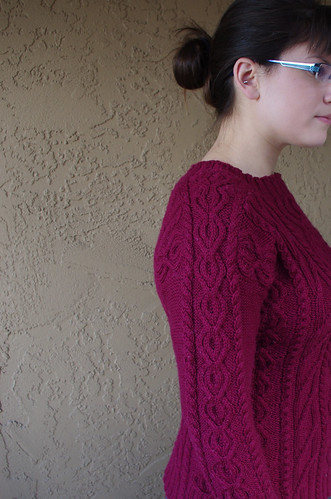

It's a saddle-shoulder, which means there's less of a defined shoulder line as there would be in a set-in or dropped shoulder sleeve. In general, if there's a line, your eye is drawn to that line, which emphasizes the size of whatever it covers. From that, I'll say there's a general rule that I don't want horizontal lines to hit at my widest points because I don't want to draw attention to them.
In contrast, I do want a vertical or diagonal line at - or very near - my shoulder point, to draw attention to the shoulder width that I do have, and de-emphasize the arm width right below it.
In contrast, I do want a vertical or diagonal line at - or very near - my shoulder point, to draw attention to the shoulder width that I do have, and de-emphasize the arm width right below it.
The only style lines that occur here are in the hems, cuffs, and upper arm - you guessed it - right where I am widest.
There are some other problems here: it's a highly textured pattern in a worsted-spun yarn, which creates a thick, heavy fabric. Using a more lofty woolen yarn probably would have been a better choice. And the arms are too short - I realized this after seaming it up, because I couldn't tell how dropped the shoulder would be before sewing it together. And unfortunately, I pretty much knew all of this stuff the minute I tried it on when it was finished. I'm hoping that someday I'll find someone who can wear it. Until then, it will sit in my closet unloved.
Take-Home Message:
For my frame, shoulders are important. Choose shoulders that emphasize the shoulder point and de-emphasize the upper arms. I've found this means that raglans, saddle-shoulders, the wrong kind of dropped shoulder, and most yoked sweaters are out.
Take-Home Message:
For my frame, shoulders are important. Choose shoulders that emphasize the shoulder point and de-emphasize the upper arms. I've found this means that raglans, saddle-shoulders, the wrong kind of dropped shoulder, and most yoked sweaters are out.
This sweater is cute, but I have a hard time styling it. It doesn't have any waist shaping, which totally doesn't work in the front, but somehow kinda does in the back. It's not horrible, but it's not quite the shape I'm going for. Because I have a full bust, hips of a similar measurement, and a tummy at my high hip, it's easy for my waist to get lost in there, and I tend to go for true waist definition whenever possible because it makes me look smaller.
So what does work about it?
It has a set-in sleeve and a detail at the neckline. The set-in sleeve gives a little bit of interest to the shoulder point (yay!) and the button & ruffle detail draws attention away from the full bust. Usually crew or jewel necklines don't work for me, partially because they mimic and over-exaggerate the roundness of my bust and rounded jawline, but the vertical button placket tones it down and makes this style pretty wearable for me.
In this case, the fix is simple:
So what does work about it?
It has a set-in sleeve and a detail at the neckline. The set-in sleeve gives a little bit of interest to the shoulder point (yay!) and the button & ruffle detail draws attention away from the full bust. Usually crew or jewel necklines don't work for me, partially because they mimic and over-exaggerate the roundness of my bust and rounded jawline, but the vertical button placket tones it down and makes this style pretty wearable for me.
In this case, the fix is simple:
Put a belt on it! Like "put a bird on it"... but with belts. This is how I end up fixing most fit problems with lightweight blouses and dresses. And, as mentioned before, adding a line emphasizes what it's covering: in this case, it's highlighting the fact that my waist (this is actually my high waist, right below the bust) is the smallest part of my torso.
Take-Home Message:
Because I have a full bust and a tummy but a smaller waist, I need to make sure I can see my smallest part, whether through waist shaping or belting.
I'll post another installment soon, and please let me know if you have any comments or questions!


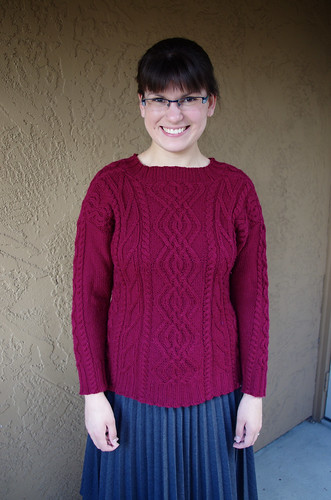

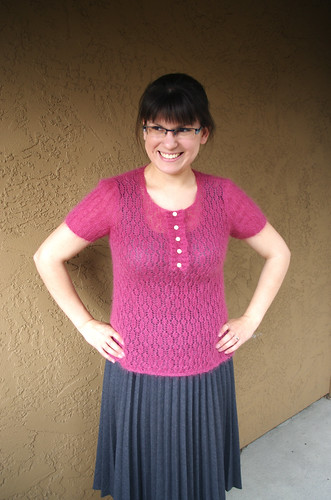
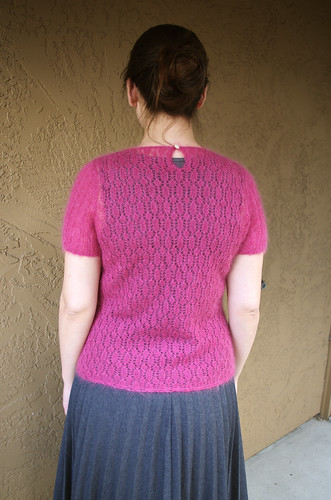
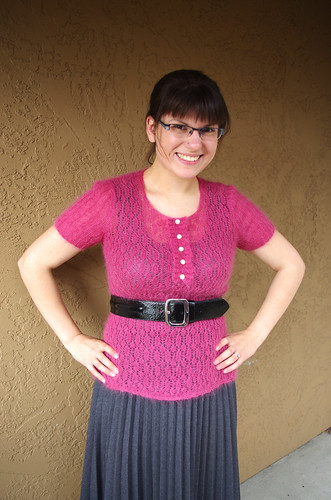
7 comments:
This is great! I've been thinking about doing that photo-with-lines thingy for a while and might actually do it after reading this.
This was a fun read - I do like a good discusson about fitting! Never actually seen the lines thing done before and I might have to have a go at it too. You might just spark off a mini-blog trend...
Thanks! I'm going to draw lines on a photo of moi and go through the same thinking. Can't wait for the next installment.
For most of my life, I grew to believe that the "hourglass" or other designated shapes were determined by the bust to waist to hips ratio. Is this thinking incorrect?
Thank you for all your feedback! I'm glad that this is an interesting topic for people, and I will definitely be sure to post a part II.
@Lucy: That is correct - shapes are determined by those ratios, but different bodies can carry weight in very different ways. For example, although my measurements are 38-29-38, I don't have very prominent hips when you look at me from the front - from what I can tell, much of my hip measurement comes from my butt, and I appear far more hourglassy from the back. There might be a woman out there who has the same measurements as me, but appears to be more of a true hourglass because she is wider side-to-side in her hip and smaller in the butt.
Another thing I try to keep in mind is that the descriptors are generalizations to describe a population, and most people deviate slightly from those descriptions or are a combination of several. For example, if a woman has a full bust size, a small waist, and very large hips, she might appear to be a triangle or pear shape - but "pear shape" usually describes a figure type with a larger lower body and small upper body. So although she technically would be a pear, she would run into other fit issues from her full bust that are more common to upside-down triangle or hourglass shapes.
Although figure types can be helpful as a starting point, it's also important to take individual factors into account when looking for a good fit.
Hope that answered your question!
Thank you for the response!
That was exactly my understanding, I'm glad I wasn't entirely misinformed. The generalization of the categories have always been awfully vague and it's rare for someone to fall exactly in one category as it is described.
Though, I never really feel that someone should need to place themselves in any category for a body type. Placing themselves in a category can give them an unrealistic expectation for something that really is so vague (as you were describing as examples for shapes that fall into the categories, but are not entirely the norm for said category).
Personal fashion is absolutely what you feel the most comfortable in; whether that is a form or shape for the clothes or the type or style. I believe fashion is about expressing yourself; to wear what you love and to be able to love yourself, no matter what "category" you fit into. c:
Thank you again!
Great tour through fit and the inner workings of what does and doesn't work. Thanks for sharing!
Post a Comment